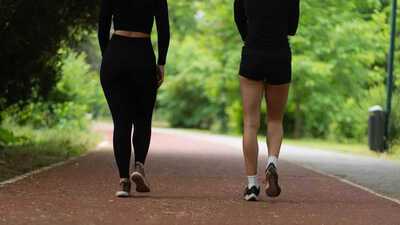We all know the feeling of sluggishness after eating heavy meals. But did you know this energy dip can raise long term health issues? Research shows Postprandial blood sugar spikes can lead to the risk of insulin resistance , heart disease and type 2 diabetes. Not just morning blood sugar, but now doctors are increasingly advising people to manage these post meal spikes . However, the good news is that these blood sugar spikes can easily get blunted by small and low effort strategies. Below we mention 3 simple meal-time tricks that can effectively reduce blood sugar spikes .
1. Calf raises after meal
The soleus muscle in the calves can sustain glucose and improve metabolism. Also, research suggests interrupted sitting with simple resistance movements show reduced postprandial insulin and improved glucose handling compared with prolonged sitting.
To practice calf raises, sit on a chair or stand and repeatedly raise your heels off the floor. Do it for 5 to 10 minutes after a meal, one can even do this while watching TV. Calf raises are beneficial because muscle activity increases glucose uptake directly into working muscle fibers, lowering circulating glucose without extra insulin. This exercise is low risk for most people.
2. Walking after meal
Research shows 10–30 minute post-meal walking reduces peak glucose and overall postprandial glycemia compared with sitting.
Take a walk outside, march in place or pace indoors, whatever suits best. A simple 10 to 15 minute brisk-pace walk can help bring down the blood sugar spike, a 20 to 30 minute walk can even provide greater benefits. This is because post meal walking uses large muscle groups to take up glucose for fuel. Research from Pubmed Central suggests that the timing of the walk matters too. Physical activity right after dinner is more effective than pre meal activity.
However, it is important for people on insulin or glucose-lowering medications to be more cautious. Fast paced walking can lower blood sugar more rapidly and may even lead to hypoglycemia.
3. Drinking small amount of vinegar before meal
Research published by NIH shows vinegar before or with a meal reduces the effect of postprandial glucose. Longer trials attempted with apple-cider vinegar also suggested improvements.
To consume vinegar, mix 1 to 2 tablespoons of vinegar in a small glass of water and drink before meal. It is essential to keep in mind that vinegar can irritate esophagus, damage tooth enamel and interact with some medications. One must check with a health professional before consuming vinegar.
These meal time tricks are general lifestyle strategies supported by research for reducing post-meal blood sugar spikes. These strategies are small, low-cost, and complementary. These can be helpful for most people, however, individuals with certain health conditions should be more careful and should only adapt these after consulting with healthcare professionals.
Disclaimer: this article is for informational purposes only and should not be substituted for professional advice.
1. Calf raises after meal

The soleus muscle in the calves can sustain glucose and improve metabolism. Also, research suggests interrupted sitting with simple resistance movements show reduced postprandial insulin and improved glucose handling compared with prolonged sitting.
To practice calf raises, sit on a chair or stand and repeatedly raise your heels off the floor. Do it for 5 to 10 minutes after a meal, one can even do this while watching TV. Calf raises are beneficial because muscle activity increases glucose uptake directly into working muscle fibers, lowering circulating glucose without extra insulin. This exercise is low risk for most people.
2. Walking after meal
Research shows 10–30 minute post-meal walking reduces peak glucose and overall postprandial glycemia compared with sitting.
Take a walk outside, march in place or pace indoors, whatever suits best. A simple 10 to 15 minute brisk-pace walk can help bring down the blood sugar spike, a 20 to 30 minute walk can even provide greater benefits. This is because post meal walking uses large muscle groups to take up glucose for fuel. Research from Pubmed Central suggests that the timing of the walk matters too. Physical activity right after dinner is more effective than pre meal activity.
However, it is important for people on insulin or glucose-lowering medications to be more cautious. Fast paced walking can lower blood sugar more rapidly and may even lead to hypoglycemia.
3. Drinking small amount of vinegar before meal

Research published by NIH shows vinegar before or with a meal reduces the effect of postprandial glucose. Longer trials attempted with apple-cider vinegar also suggested improvements.
To consume vinegar, mix 1 to 2 tablespoons of vinegar in a small glass of water and drink before meal. It is essential to keep in mind that vinegar can irritate esophagus, damage tooth enamel and interact with some medications. One must check with a health professional before consuming vinegar.
These meal time tricks are general lifestyle strategies supported by research for reducing post-meal blood sugar spikes. These strategies are small, low-cost, and complementary. These can be helpful for most people, however, individuals with certain health conditions should be more careful and should only adapt these after consulting with healthcare professionals.
Disclaimer: this article is for informational purposes only and should not be substituted for professional advice.
You may also like

America's 250th birthday: Is US getting a $1 Trump coin? Here's what Treasury said

'Specific' spare tyre rules that could get you pulled over

'I need your help': Vehicle rams steps of Los Angeles City Hall; cardboard sign has message for Donald Trump

UN chief welcomes Hamas' statement on US Gaza proposal

True crime series is 'misguided' yet 'eye-opening' say fans - streaming on Disney






